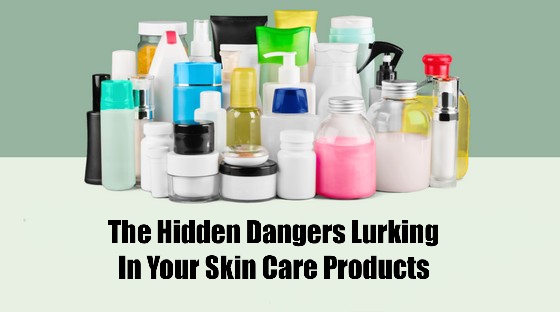In our quest for glowing, youthful skin, we often turn to a variety of skincare products promising miraculous results. However, not all that glitters is gold. Many products on the market contain harmful ingredients that may cause long-term damage to your skin and overall health. While some of these components are masked by scientific names or labeled as “natural,” they can wreak havoc if used regularly.
In this blog, we’ll highlight some of the most common yet harmful ingredients hidden in your skincare routine that you may not know about. Awareness is the first step toward healthier skin and better choices!
1. Parabens
Parabens are one of the most commonly used preservatives in skincare products. They prevent bacteria and mould from growing in products, extending shelf life. However, studies have shown that parabens can mimic estrogen in the body, disrupting hormonal balance. They’ve been linked to reproductive issues and breast cancer.
Watch out for: Butylparaben, Methylparaben, Propyl paraben, and Ethyl paraben.
Safer Alternatives: Look for products with natural preservatives like Vitamin E (Tocopherol) or grapefruit seed extract.
2. Fragrance (Parfum)
Fragrance may seem harmless, but it’s one of the top allergens in skincare. The term “fragrance” can include hundreds of chemicals, many of which are harmful to human health. Fragrance formulas are considered trade secrets, so companies are not required to disclose the specific chemicals used. Unfortunately, many of these chemicals are linked to allergies, dermatitis, respiratory issues, and even hormone disruption.
Watch out for: Synthetic fragrances or perfume listed in the ingredients.
Safer Alternatives: Choose products that use essential oils for scent or opt for fragrance-free formulas.
3. Sulfates
Sulphates are common in cleansers, shampoos, and face washes because they create that satisfying lather we often associate with cleanliness. However, sulfates like Sodium Lauryl Sulphate (SLS) and Sodium Lauretha Sulfate (SLES) can strip the skin of its natural oils, causing dryness, irritation, and breakouts. They can also be too harsh for sensitive skin types and may contribute to long-term skin barrier damage.
Watch out for: Sodium Lauryl Sulfate (SLS) and Sodium Laureth Sulfate (SLES).
Safer Alternatives: Look for sulfate-free cleansers that use milder surfactants like Coco-Glucoside or Decyl Glucoside.
4. Phthalates
Phthalates are used to make fragrances last longer and to soften and increase the flexibility of plastics in beauty products. Unfortunately, they’re also linked to endocrine disruption, reproductive toxicity, and even developmental issues. The worst part? Phthalates are often not listed on ingredient labels, hiding under the term “fragrance.”
Watch out for: DEP (Diethyl phthalate) and labels that simply list “fragrance.”
Safer Alternatives: Opt for phthalate-free products and brands that fully disclose their ingredient lists.
5. Formaldehyde and Formaldehyde-Releasing Preservatives
Formaldehyde is a known carcinogen, but it’s still found in some skincare products as a preservative. While it’s not always listed outright, some chemicals release formaldehyde over time. These chemicals can lead to skin irritation, allergic reactions, and over time, have been linked to certain cancers.
Watch out for: Quaternium-15, DMDM Hydantoin, Imidazolidinyl urea, and Diazolidinyl urea.
Safer Alternatives: Look for formaldehyde-free products or those that use preservatives like phenoxyethanol.
6. Mineral Oil
Mineral oil, derived from petroleum, is often found in moisturizers and lotions because it creates a barrier on the skin to lock in moisture. However, it can also clog pores, leading to breakouts and blackheads. Long-term use can interfere with the skin’s natural ability to breathe and repair itself.
Watch out for: Mineral oil, petroleum jelly, and paraffin.
Safer Alternatives: Natural oils like jojoba, argan, or rosehip oil provide hydration without the pore-clogging risks.
7. Oxybenzone (and other harmful chemical sunscreens)
Oxybenzone is a chemical commonly found in sunscreens that has been linked to hormone disruption and allergic reactions. It’s also harmful to marine life, particularly coral reefs. Other chemical sunscreens like octinoxate and homosalate have raised similar concerns.
Watch out for: Oxybenzone, octinoxate, homosalate, and avobenzone.
Safer Alternatives: Choose physical sunscreens with active ingredients like zinc oxide or titanium dioxide, which are both safe for the skin and the environment.
8. Triclosan
Triclosan is an antibacterial agent found in products like cleansers and hand sanitizers. Although it’s effective at killing bacteria, it’s also linked to hormone disruption and may contribute to antibiotic resistance.
Watch out for: Triclosan and triclocarban.
Safer Alternatives: Opt for products with natural antibacterial agents like tea tree oil or rosemary extract.
How to Protect Your Skin and Health
Making informed choices is key to ensuring your skincare routine is both effective and safe.
Here are a few steps to safeguard your skin:
Read ingredient labels: Familiarize yourself with harmful chemicals and avoid products that contain them.
Choose clean beauty brands: Look for brands committed to transparency and that avoid controversial ingredients.
Patch test new products: Before applying a new product to your face, test it on a small area of your skin to check for any adverse reactions.
Simplify your routine: Fewer products with simpler, natural ingredients often lead to healthier skin.
Final Thoughts
Your skincare routine should nourish and protect your skin, not expose it to hidden dangers. By being mindful of the ingredients in your products and opting for cleaner, safer alternatives, you can maintain healthy, glowing skin without compromising your health in the long run. After all, beauty should never come at a cost to your well-being!
Remember, knowledge is power — especially when it comes to your skincare choices.

